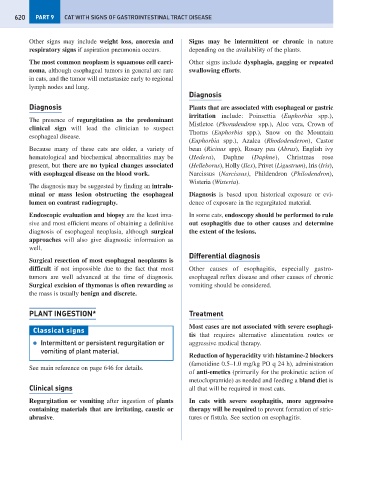Page 628 - Problem-Based Feline Medicine
P. 628
620 PART 9 CAT WITH SIGNS OF GASTROINTESTINAL TRACT DISEASE
Other signs may include weight loss, anorexia and Signs may be intermittent or chronic in nature
respiratory signs if aspiration pneumonia occurs. depending on the availability of the plants.
The most common neoplasm is squamous cell carci- Other signs include dysphagia, gagging or repeated
noma, although esophageal tumors in general are rare swallowing efforts.
in cats, and the tumor will metastasize early to regional
lymph nodes and lung.
Diagnosis
Diagnosis Plants that are associated with esophageal or gastric
irritation include: Poinsettia (Euphorbia spp.),
The presence of regurgitation as the predominant
Mistletoe (Phoradendron spp.), Aloe vera, Crown of
clinical sign will lead the clinician to suspect
Thorns (Euphorbia spp.), Snow on the Mountain
esophageal disease.
(Euphorbia spp.), Azalea (Rhododenderon), Castor
Because many of these cats are older, a variety of bean (Ricinus spp), Rosary pea (Abrus), English ivy
hematological and biochemical abnormalities may be (Hedera), Daphne (Daphne), Christmas rose
present, but there are no typical changes associated (Helleborus), Holly (Ilex), Privet (Ligustrum), Iris (Iris),
with esophageal disease on the blood work. Narcissus (Narcissus), Phildendron (Philodendron),
Wisteria (Wisteria).
The diagnosis may be suggested by finding an intralu-
minal or mass lesion obstructing the esophageal Diagnosis is based upon historical exposure or evi-
lumen on contrast radiography. dence of exposure in the regurgitated material.
Endoscopic evaluation and biopsy are the least inva- In some cats, endoscopy should be performed to rule
sive and most efficient means of obtaining a definitive out esophagitis due to other causes and determine
diagnosis of esophageal neoplasia, although surgical the extent of the lesions.
approaches will also give diagnostic information as
well.
Differential diagnosis
Surgical resection of most esophageal neoplasms is
difficult if not impossible due to the fact that most Other causes of esophagitis, especially gastro-
tumors are well advanced at the time of diagnosis. esophageal reflux disease and other causes of chronic
Surgical excision of thymonas is often rewarding as vomiting should be considered.
the mass is usually benign and discrete.
PLANT INGESTION* Treatment
Most cases are not associated with severe esophagi-
Classical signs
tis that requires alternative alimentation routes or
● Intermittent or persistent regurgitation or aggressive medical therapy.
vomiting of plant material.
Reduction of hyperacidity with histamine-2 blockers
(famotidine 0.5–1.0 mg/kg PO q 24 h), administration
See main reference on page 646 for details.
of anti-emetics (primarily for the prokinetic action of
metoclopramide) as needed and feeding a bland diet is
Clinical signs all that will be required in most cats.
Regurgitation or vomiting after ingestion of plants In cats with severe esophagitis, more aggressive
containing materials that are irritating, caustic or therapy will be required to prevent formation of stric-
abrasive. tures or fistula. See section on esophagitis.

